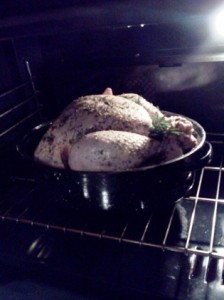Thanksgiving seems to be the most challenging day in the kitchen for many cooks. Many might be more thankful if they weren’t so distressed by their culinary responsibilities. Ovens that sit cold 364 days of the year are put to use as the focal point of the feast cooks for hours while accompaniments are assembled to go with it. Prayer and effort are mustered as these home chefs do their best to not have a dry bird. With many factors at play, there are often unexpected challenges that arise and create a dilemma. This list of tips will hopefully not be needed; but should a problem arise, these pointers might help you save the day.
Get geared-up
You don’t need every turkey gadget on the market, but you do need a few basics to successfully accomplish your goal. The most important being a method to cook the bird. Whether you smoke, fry, bake, roast, or grill, make certain NOW that your heat source is reliable, available, and fueled if necessary. Test your oven before Thursday morning. According to one helpful “home economist” at the Butterball Hotline, one caller lost the ability to bake in his oven part way through the cooking process and had several creative ideas for how to finish the cooking. Though both do contain heating elements, neither the dryer or dishwasher provide adequate heat to safely cook a bird.
If your oven doesn’t work, consider finishing the bird on the grill, in an electric roaster, or cut it into smaller pieces and sauté or cook in the microwave. Just be certain whatever you do that you avoid cross contamination by using the same utensils on cooked meat that you used on the underdone bird.
Regardless of how delicious you manage to make your meal, if someone ends up sick, it will be memorable for all the wrong reasons. Don’t “cross contaminate” with raw poultry. Though in the past it was recommended to rinse your turkey before cooking it, they have now found that it significantly increases the risk of contamination. Also be very careful not to spread germs by using kitchen tools on the raw meat then with other items, or from the liquid that escapes as the bird thaws.
Timing is everything
Carefully check the label on your bird for suggestions on cook time. A minute per pound method of calculating can result in poorly cooked meat that is often over done. Use a probe thermometer throughout the cooking process to keep an eye on how quickly things are cooking. When it comes to thawing, timing is critical too. For frozen birds calculate 24 hours in the refrigerator for every 4 pounds of turkey. Do not keep the turkey at room temperature to thaw. This is dangerous. If you need to speed up the thawing process, you can do so by placing the turkey in cold water. Don’t thaw too soon though — a fresh or thawed bird should be eaten within 2 to 4 days of purchase when stored properly in a 40° F degree refrigerator. If, however, your refrigerator is a little warm (as many are), this may not hold true. Vacuum sealed turkeys (like Butterball) can keep longer when fresh and refrigerated properly, but check the tag for the recommended dates.
It is inevitable in many homes that if the turkey is done, as expected, there will be some delay. It may be as simple as needing to stop to make the gravy or as complicated as delayed travelers. In any situation, it is critical that the bird be removed from the oven as soon as the thigh meat at the thickest part is 180° F. The residual heat of the bird will help that temperature rise about 2 degrees after removal from the oven. If you were to leave the bird in the oven, or even to move it to a warming oven, there would still continue to be enough heat to keep things cooking and dry out the bird. The best thing to do to buy a little time after your bird is done is to remove it from the oven and cover it with foil — this will keep things perfect for about 30 minutes. If it will be longer than that, cover in foil, then wrap it in a couple of large clean towels, then newspaper, then put it in a cooler or cardboard box. By doing this the turkey will stay warm and retain a safe temperature (over 140° F) for 3 hours. If your meal is going to be delayed any longer than that, then you will need to chill the turkey as quickly as possible (it is best to slice it to help it chill more quickly).
Store safely
Once the turkey is finally done, carve it in the kitchen so the mess is more contained. Slice and serve what your family will eat. The remainder of the meat should be removed from the bone and stored safely in your refrigerator or freezer. As with any meat, eat within 2-4 days.
And, finally, turn to the experts if you have a difficult question that you can’t find a reliable answer for… Butterball has a free 800 number you can call to speak to their extensively trained Home Economists if you need help: 1-800-BUTTERBALL



